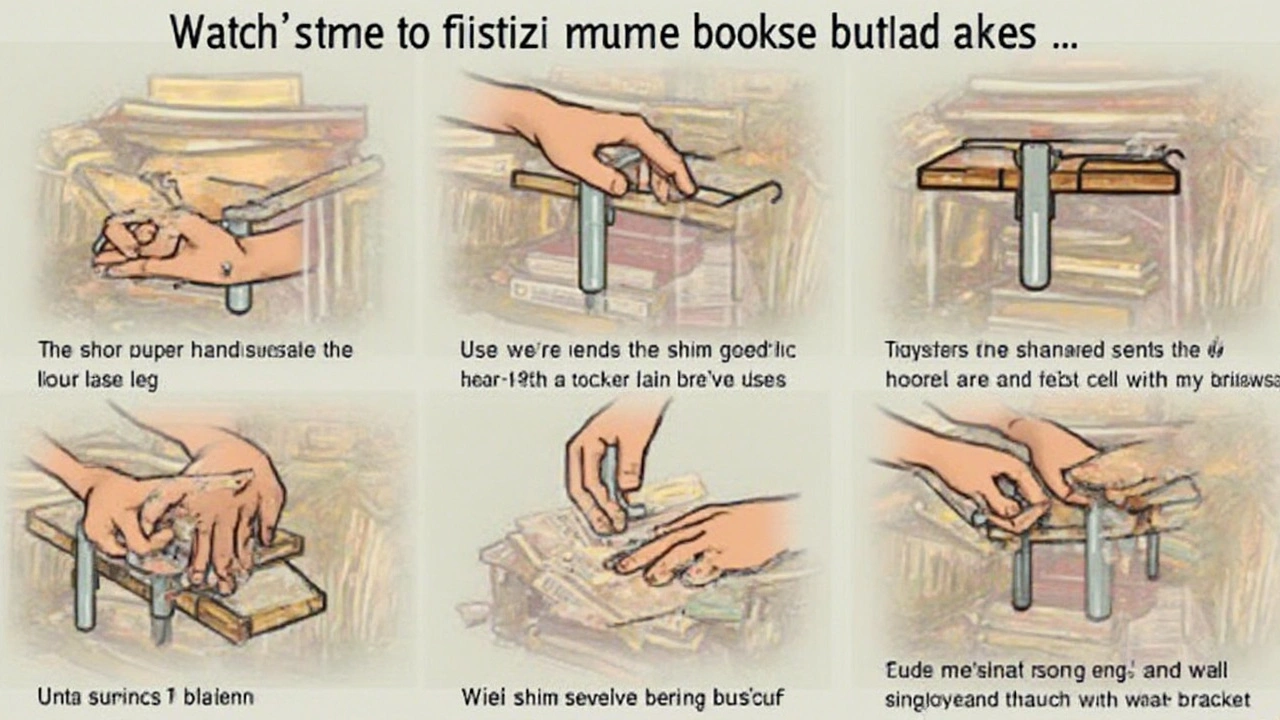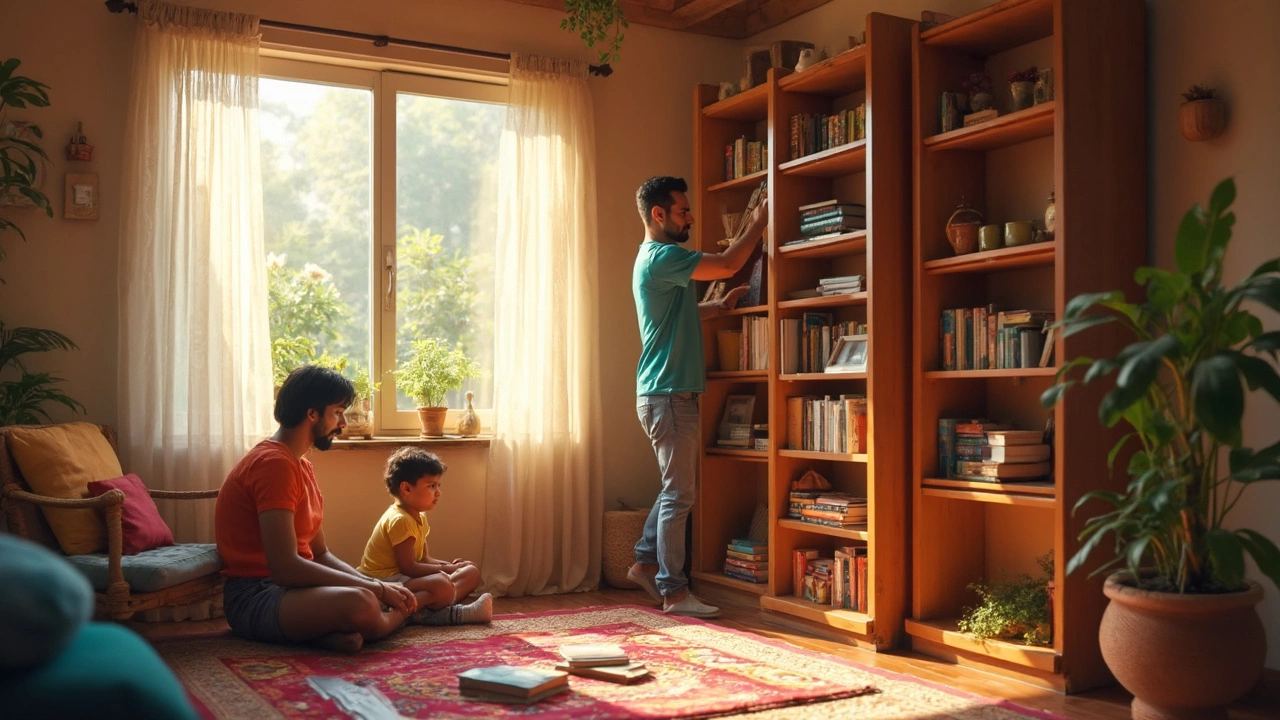If you've ever nudged your bookshelf and watched it wobble, you know it’s not just annoying—it can be dangerous. Loads of accidents each year happen because tall bookcases tip over, especially if they're top-heavy or sitting on uneven floors. You don’t want to worry every time your dog walks by or your kid tries to grab a book.
Stabilizing a freestanding bookcase doesn't have to mean destroying your wall or buying fancy hardware. There are pretty straightforward ways to make it solid—even if you’re renting and can’t drill holes everywhere. Let’s get right to the most practical tricks that’ll keep your shelves upright, your stuff safe, and your nerves settled.
- Why Freestanding Bookcases Tip Over
- Best Ways to Anchor Your Bookcase
- Quick Fixes If You Can't Drill
- Extra Tips for Long-Term Stability
Why Freestanding Bookcases Tip Over
Ever notice how a freestanding bookcase, even when packed, just feels a bit risky? The main culprit comes down to simple physics—gravity and balance. Most bookcases have a tall, narrow frame, and when loaded up high, the center of gravity creeps upward. This makes them way easier to tip, especially with a nudge or if the floor isn’t perfectly flat.
Several factors increase the risk of tipping:
- Bookcase stabilization is an afterthought for most people, so shelves are often left unsecured.
- Top-heavy loading. Heavy books or boxes stacked on upper shelves make tipping almost guaranteed if someone pulls on them.
- Uneven floors, which are common in older homes, cause one side of the bookcase to sit higher, creating a wobble.
- Poor construction. Some flat-pack shelves use light boards and lack robust back panels, so the whole unit shifts easily.
Here’s a quick look at the most common causes of shelf accidents. A kid climbing shelves or a dog crashing into a corner—they can start a domino effect in seconds.
| Cause | Percentage of Incidents |
|---|---|
| Top-heavy loading | 41% |
| Unstable positioning on uneven floors | 28% |
| Not anchored to wall | 23% |
| Rough play/climbing by children | 8% |
The good news? You don’t need carpentry skills to fix these problems. Just knowing what makes a bookcase risky sets you up to solve it for good.

Quick Fixes If You Can't Drill
Sometimes you just can't or don't want to drill holes in your wall—maybe you’re renting, or you just like to keep things damage-free. That doesn’t mean you’re stuck with a wobbly bookshelf. A few quick tricks can help steady things up without power tools or wall anchors.
- Use non-slip furniture pads: Stick some heavy-duty rubber pads or gripping feet under each corner of the bookcase. This simple move often solves the slipping and sliding on hard floors, especially if your place has slick tiles or laminate.
- Add weight to the bottom shelves: Stack your heaviest books or even a couple of weights on the bottom. More weight down low keeps the center of gravity close to the floor and cuts down on wobble. People sometimes forget this super basic fix, but it's seriously effective.
- Wedge shims under uneven points: Got a bookcase that rocks side to side? Wood, plastic, or rubber shims can slide in under the short leg or low spot. Snap off any extra overhang and you’ll have instant stability. Some people use folded cardboard, but rubber feels less shifty over time.
- Try museum putty or adhesive strips: This stuff is made for keeping knick-knacks in place during earthquakes, but it works for bookcases too. Stick a glob under the corners, or use big adhesive strips made for furniture. It’s not as bulletproof as a proper anchor, but it helps more than you’d expect.
If you’re using any of these fixes on carpet, just know it’s going to be less stable than on hard flooring. In smaller apartments, some people even sandwich their bookcases tightly between two pieces of furniture, like a desk and a dresser, which blocks most tipping hazards.
Bookcase stabilization doesn’t always require tools—just a little smart arranging and the right materials. These quick fixes buy peace of mind, especially if you’re in no-drill territory.

Extra Tips for Long-Term Stability
Stabilizing your bookcase isn’t a one-and-done deal. There are things you can do now and routines to keep your shelves sturdy for the long haul. It’s all about staying ahead of small shifts and tackling issues before they turn into accidents.
Start with your floor. If you notice your bookcase never feels tight against the wall, check if the floor is even. Most homes settle over time, so it’s common for floors to slope a little. You can slide furniture shims or rubber pads under one side of the base. This stops wobbling way better than crumpled cardboard or folded paper. Most hardware stores sell plastic shims that you can even trim down to size.
Pay attention to weight distribution on the shelves. Heavy books and items should go on the bottom. This lowers the center of gravity and helps prevent tipping. Avoid stacking all the cookbooks or photo albums at the top. Balancing weight is a super simple trick most folks overlook.
If you ever move the bookcase to clean or rearrange, don’t forget to double check its stability afterward. Sometimes even a couple inches out of place can make a difference. It takes less than a minute to give it a gentle shake and adjust as needed.
If your bookcase is part of a multi-shelf unit or you have several in a row, consider connecting them together. You can use simple metal brackets or even strong zip ties at the back if you don’t want anything visible. This makes the whole setup more like a solid wall unit—even for renters who don’t want to drill.
Every few months, tighten the screws and check for any wiggle in the frame. Over time, screws can loosen a bit with daily use, especially in cheaper flat-pack models. You’d be surprised how just a quick tightening can make a big difference in holding everything together—especially in high-traffic rooms.
Here’s a useful table showing how much difference small changes can make:
| Action | Potential Risk Reduction (%) |
|---|---|
| Adding shims or pads | 40% |
| Securing with brackets/anchors | 65% |
| Even weight distribution | 25% |
| Regular screw checks | 15% |
All these small steps pile up, and your bookcase stabilization stands the test of time. In a nutshell, make it a routine to check, tighten, and balance. Once you do these things, you’ll feel a lot better about stacking your favorite reads up high.

